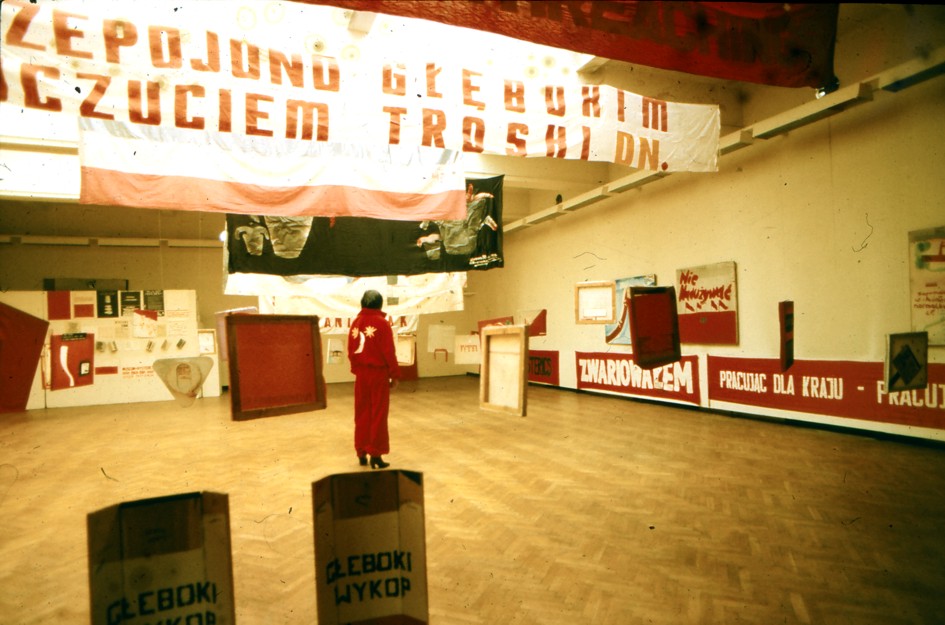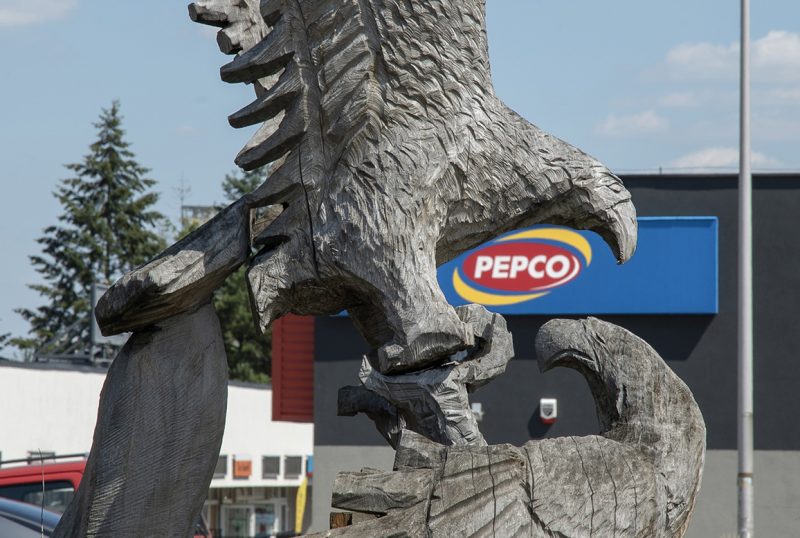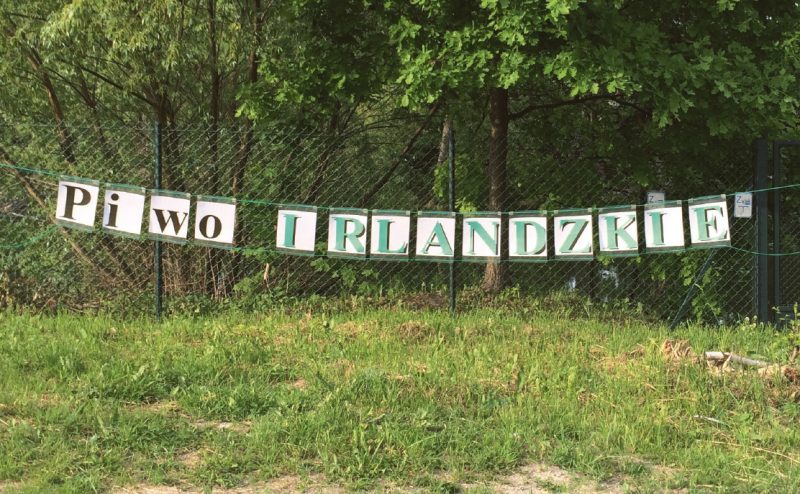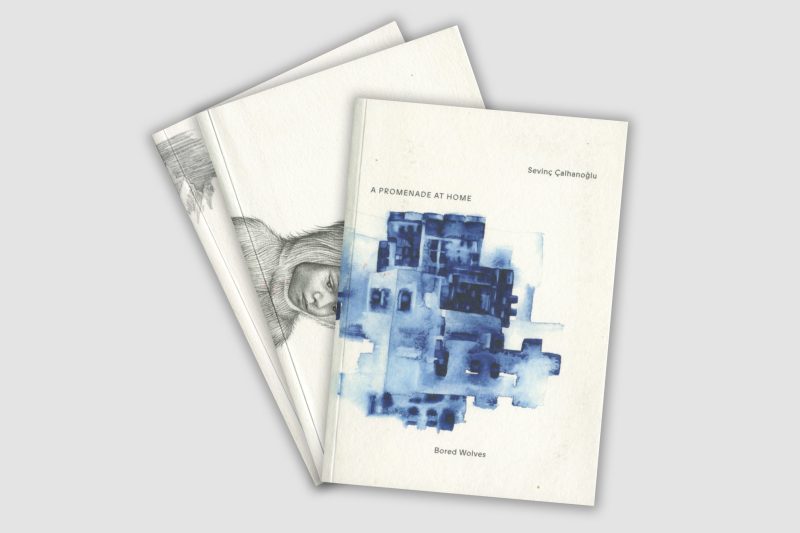
Ewa Tatar (it/her)
A COMMUNITY OF MEANINGS? EXOTICISM? THE PERIPHERY LOOKS AT THE CENTRE
The present paper is an outline of the history of an unprecedented project: the Art Exhibitions Offices (BWAS), a network of contemporary art galleries established in the times of the Polish People’s Republic. It shows the transformation of this structure, its decentralisation and the solutions applied to individual galleries in relation to historical and economic changes. The text is based on archival research conducted by the author between 2014 and 2018. BWAS can be seen as an example of the organisation of artistic life in the form of a horizontal network, based on the cooperation of its individual links.
In addition to the huge role they played in the animation of the visual arts community and the diffusion of artistic life in post-war Poland, they were also a way of managing the leisure time of a society undergoing urbanisation. Art Exhibition Office was the name given to the municipal galleries established by a decision of the then Ministry of Culture with its headquarters in the Warsaw’s Zachęta Gallery in 1949.1 The first branch of the Central Art Exhibition Office (CBWA) was established in Katowice (1 September 1949), and its activities covered the Katowice and Opole voivodeships. By the time of the first decentralisation (1962), i.e., the handing over of the administration of the galleries to the local authorities (Voivodeship National Councils), there were 11 branches in the BWA network: in Kraków, Katowice, Opole, Wrocław, Poznań, Szczecin, Gdańsk, Bydgoszcz, Łódź, Olsztyn and Piastów (known as the Capital BWA).
The tasks of each of the Offices included ‘the dissemination of contemporary fine arts’, as the model statute of 1962 reads.2 The report of the 1967 convention of the BWAS’ managers3 emphasised the need to reach out as widely as possible to the working-class communities. Dissemination was to take place through the organisation of exhibitions of Polish art in major urban centres, as well as educational actions in the provinces and cooperation linking associations of artists with social, youth or workplace organisations in order to organise exhibitions and actions to popularise art, to cooperate with the media in order for the gallery to promote its own activities and publications, but also the organisation of courses in the visual arts, supporting artists with purchases and acting as intermediaries in the sale of works of art, as well as collecting documentation of contemporary artistic life in the given area. Each office was managed by a manager (later a director) in charge of the programme, and the model institution should also have employed an educational and technical instructor, an accountant, a clerk, a cashier, a maintenance craftsman, an assembler, a maintenance worker, a central heating stoker and a receptionist-informant. Later, there were even ideal staff sets developed, adapted to the size of the institution.
In 1966, the cBWA Field Division (also referred to in the documents as ‘Department’) was established. It was in charge of providing substantive support to galleries scattered across Poland, ensuring the smooth functioning of the entire network of institutions, stimulating evaluation and collecting data from the field; Maria Domurat, who ran this department, highlighted in her notes both similarities and differences in their functioning. This is what she said about the tasks and forms of the Department’s work: ‘A lot of paperwork, making plans and reports. I gradually began to create collections: primarily prints. We used them to organise travelling exhibitions, which were similar but consisting of reproductions, with descriptions and texts. They travelled to distant places and were virtually the only contact with art there. In the beginning, I worked alone but the staff grew as more Offices were established. We organised art knowledge tournaments and conventions of directors. It was there that closer contacts were made, exhibitions were exchanged, and very often several Offices contributed to one decent catalogue. They were led by great people, usually visual artists, sometimes art historians, a group of enthusiasts. BWAS had a wide range of activities that involved entire voivodeships. We drew the ministry’s attention to various needs. At the time, these galleries were very general in nature. We were missing authorial programmes’.4
Art Exhibition Offices existed in 47 of the 49 voivodeships. They had their delegations and field galleries, which, from the 1960s onwards, were gradually transformed into independent institutions. They were created up to 1988 and from 1990 onwards, they were partly liquidated by the local authorities. After the administrative reform in 1999, only those with the strongest environmental position remained. Alongside systemic and economic changes, they also underwent changes in personnel at the time. Currently, the galleries that were formerly part of the BWA network operate under different names: as municipal galleries, run by local authorities or incorporated into the structures of cultural centres. About half of the former network’s sites survived the economic transformation and the administrative reform. The name itself, together with the accompanying sentiment, was adopted as early as the 2000s by two commercial galleries in Warsaw: Biuro Wystaw i Biuro Wystaw Artystycznych. Some institutions, after identity perturbations manifested in the evolution of their names, have returned to using the abbreviation BWA. Alongside names that indicated the style of operation (‘offices’), we therefore have those that focus on exhibition (‘galleries’) but also those that refer to the previous functions of the location, i.e., ‘arsenals’, which was particularly evocative in the 1990s, when institutions that changed together with the art itself had to defend freedom of expression under pressure from conservative politicians and the public.5 Looking at the transformation of logos, one could write a history of the aesthetics of Polish transformation in the second half of the 20th century, but also trace the evolution of each centre’s identity. So, we can see the journey from the 1950s’ aesthetic built in the spirit of socialist-realist formalism through the 1960s’ evolution towards modernist formalism to succumbing to the aesthetic individualism of Polish capitalism, and later, after 2000, the return to modernist traditions, but with the trend for harmonious design classics and reaching for an ethos of education in the spirit of balanced proportions, modern taste and order. I would also add that most of the BWAS did not (and do not) have their own buildings; they operated in the premises of the Association of Polish Artists and Designers or ZPAP (e.g., in Kraków in the Dom Plastyka facility) or museums (e.g., BWA in Katowice organised exhibitions in the Upper Silesian Museum in Bytom). Gradually and sparsely, pavilions designed specifically for art were built in the 1960s and 1970s, including in Kraków, Olsztyn, Bydgoszcz, Katowice, Zielona Góra and Częstochowa.
At the network’s beginnings, the programme includes reviews of the current activities of local artists (accompanied by black-and-white catalogues without reproductions but with a list of works), commemorative exhibitions (on patriotic or social themes), often combined with competitions for visual artists, and touring exhibitions of original works and reproductions. Most of the exhibitions at the time were managed according to the CBWA’s central plan, with almost all institutions of the time hosting, for example, the posthumous exhibition of the proto-socialist-realist artist Feliks Kowarski or, after the 1956 ‘thaw’, the exhibition of Picasso’s prints. The 1960s was a moment when the centres became independent in planning their programme and when interesting exhibition and festival initiatives emerged on the initiative of local communities, including: the Kraków Meetings or the legendary Golden Grape in Zielona Góra. It was the golden age of BWAS, immortalised, for example, in Janusz Morgenstern’s feature film Jowita (1967), where the gallery building near the Kraków’s Planty Park, designed by the modernist Krystyna Tołłoczko-Różyska, combines historicism and modernity, and the BWA’s vernissage of paintings by the magic realism painter Anna Güntner, alongside the Cracovia hotel opened in the same period, play a similar role to that of sports cars in the French New Wave cinema.
The 1970s saw the last chance to flourish, but also a gradual loss of quality to quantity: it was then that dozens more independent centres were established in the newly created voivodeships. This period was marked by the beginning of the establishment of a kind of canon of art shown at BWA, which continued in the next decade: a list of names of artists working mainly in traditional art media, often valid in smaller establishments to this day, a canon, let us add, that was heavily ridiculed by the young generation forming the language of art in the mid-1990s.6 The 1980s were impacted by the martial law-related boycott of state institutions, artists identifying themselves with the democratic opposition did not want to exhibit in them, and some galleries, such as the one in Lublin, in order to fulfil their obligations to the organiser (usually the Department of Culture of the Voivodeship or Municipal National Council – the equivalent of the city hall at the time), used to install for several months exhibitions made of posters and archive materials. The socio-political crisis in the country was followed by the economic crisis, and, quite interestingly, this too is evident in the profile of the galleries’ programme offer. At a time when the permanent subsidy (fixed funds allocated from the organiser’s budget on an annual basis and enabling basic activities to be run) is only sufficient to pay staff salaries and maintain the premises (often rented), some galleries seek sponsors and co-organisers of projects (e.g., publish full-page advertisements in exhibition catalogues), others try their chances at independent economic activity and services, selling works of art or providing exhibition services (in March 1989 the BWA in Koszalin was transformed into Biuro Wystaw Artystycznych i Usług Plastycznych [Office of Art Exhibitions and Services]; such art services had already been provided in Rzeszów and Piła), as well as transport, craft work (the BWA in Krosno opened a carpentry service), the provision of exhibition halls and equipment for a fee, as well as running cafés.7 The existence of state exhibition facilities is threatened by reforms, such as, for example, the reprivatisation: ‘The excellent working gallery in Płock is housed in a private building whose owner (now living in Detroit) decided to donate the property to the Płock Scientific Society’.8
In the 1990s, the Central BWA was transformed into the Zachęta Gallery and the Field Division was liquidated. The staff managing the former network’s galleries no longer meets at annual conventions. The political transformation in Poland was survived by centres run by the most charismatic and determined directors-curators, who managed to offer their most interesting programmes and thus introduce the galleries they managed to the new circulation of art works that had been emerging since the second half of the 1990s. In this new circulation, institutions financed from the state budget compete side by side, including some of the former BWAS and the Foksal Gallery, avant-garde in terms of programme, but run since 1966 from the funds of the state enterprise Pracownie Sztuk Plastycznych, as well as art centres created on the initiative of artists, such as the Ujazdowski Castle Centre for Contemporary Art in Warsaw, which originated from the circle of Akademia Ruchu, or the Łaźnia Centre for Contemporary Art in Gdańsk, which originated from the circle of the Wyspa Gallery. The newly established art circulation also includes institutions that are independent of public funding in terms of budget: sites established on the basis of avant-garde initiatives, author galleries dating back to the 1970s, as well as completely new ones, transforming over time from critical initiatives into commercial galleries, such as Galeria Raster. The ‘evaluation’ of the suitability of arts institutions in cities was sealed by the 1999 administrative reform. And the contemporary BWAS are often defined by 30- and 40-year-olds brought up as viewers by the previous directors-curators of these institutions.
What were the BWAS actually doing? In addition to exhibition activities, they focused on disseminating knowledge about art. Most of the institutions, operating in small towns, faced a ‘lack of the habit of going to exhibitions’ and were primarily oriented towards educational activities. Lectures were organised in the field, village, workplace, youth and senior clubs (the BWA in Koszalin even cooperated with kindergartens), there were also presentations by artists, screenings of films about art, exhibitions of charts and reproductions (prepared mainly by the Field Department of the CBWA) in community centres, cafés and clubs, even the garrison clubs.
What were the BWAS actually doing? In addition to exhibition activities, they focused on disseminating knowledge about art. Most of the institutions, operating in small towns, faced a ‘lack of the habit of going to exhibitions’9 and were primarily oriented towards educational activities. Lectures were organised in the field, village, workplace, youth and senior clubs (the BWA in Koszalin even cooperated with kindergartens), there were also presentations by artists, screenings of films about art, exhibitions of charts and reproductions (prepared mainly by the Field Department of the CBWA) in community centres, cafés and clubs, even the garrison clubs. The Education Department of the CBWA organised a national Art Knowledge Tournament every year in cooperation with another BWA, in which teams from all over the country took part. A lot of educational art history exhibitions were created in the form of charts to be displayed in cultural centres, clubs, e.g., in housing estates or community centres, such as in working places. School galleries, field galleries, village galleries (an initiative near Nowy Sącz) were run. Local professional audiences were also looked after. The animation of local artistic communities was often carried out in collaboration with the local structures of the ZPAP ; forms of this animation included reviews of current work (e.g., March Salons in Zakopane) covering a particular medium (e.g., South Poland’s Sculpture of the Year in Kraków) or open-air painting events. These were often associated with the local industry, such as the ceramic open-air workshop in Bolesławiec run by the BWA in Jelenia Gora, the jewellery open-air workshop in the Copper Basin in Legnica, the stone sculpture workshop of the BWA in Kielce that was the co-initiator of the creation of the Centre of Polish Sculpture in Orońsko, or the open-air workshop at the State Agricultural Farm (pgr), organised by the BWA in Kalisz. Sometimes the themes of the open-air workshops or reviews were dictated by the most popular branch of visual arts in the region. Some open-air workshops are still organised on a regular basis, e.g., workshops for illustrators run by the BWA in Zamość or workshops for pastel painters run by the BWA Sokół in Nowy Sącz. The animation of cooperation between artists and industrial centres resulted, for example, in the aesthetic co-creation of the surroundings, as sometimes works presented at temporary exhibitions (e.g., the Exhibition of Outdoor Sculpture in Wrocław in 1958 or the Exhibition of Sculpture in Planty Park in Kraków in 1962) remained in the city space, while, for example, the results of open-air workshops in the open-cast stone mines in Szydłowiec (Masovia Land) or Wietrznia (Kielce) were used to decorate housing estates throughout Poland. Some BWAS, such as the one in Zielona Góra, have become a permanent part of Polish art history by being co-organisers of a canonic event: the Golden Grape Symposium. The event was founded in Zielona Góra on the initiative of the institution’s director, a visual artist associated with the post-constructivist avant-garde of the time, Marian Szpakowski. The most powerful editions, co-curated with the Foksal Gallery circle, introduced an original take on the most important visual art trends of the 1960s (installations, happenings) to Polish artistic life.10
BWA undertook artistic and exhibition exchanges, also in the international field (mainly working in their border region, e.g., Białystok cooperated with the National Museum in Vilnius, Przemyśl with the Ukrainian centres). Nationwide reviews with competitions were organised, usually in the biennial mode, dedicated to, among others, printmaking, landscape photography, applied glass, weaving, watercolour, etc.; they were most often organised in partnership with the relevant sections of the ZPAP . Documentation of exhibitions in the region was taken care of and archives of the local artists were maintained. Care was taken to ensure the continuity of the artistic tradition by organising, for example, the Interdisciplinary Senior Open-Air Workshop in Świeradów-Zdrój (from 1978). Exhibitions included mediation in the sale of works, fairs (e.g., of artistic jewellery in Legnica) and art exchanges were organised with proceeds being transferred to the artists or to social purposes. Collections were taken up to support the artists. Some events launched in the past (sometimes of international scope) and devoted to particular media (e.g., interior architecture and graphic design in Kraków, painting in Bielsko-Biała) are still being organised. The 1960s were a golden age of Polish art co-created by state institutions. General artistic trends are collected and dictated by the CBWA with major review exhibitions or monographs of avant-garde artists such as Alina Szapocznikow, Tadeusz Kantor or Henryk Stażewski. BWAS mainly promote the formal aesthetic, but those operating in cities and towns that are also strong art centres, such as Kraków or Zakopane, or led by a charismatic individual, such as the one in Zielona Góra, allow artists to shape the programme and thus diversify the image of the era as seen from the perspective of the periphery. In the next decade, BWAS irrevocably gave way to author’s galleries. Moreover, after the period of the martial law, they lost their supra-local significance. In the 1990s, they mostly remain outside the rhythm of events in the visual arts.
What remains of the tissue and idea of the BWA today, and how can they be useful in creating a horizontal network of connections of the contemporary art scene beyond the centre? This was one of the questions posed by Ewa Tatar and Ewa Łączyńska-Widz when they re-initiated the annual reunion of the programme staff of the existing BWAS in Tarnów in 2014, within the programme of the open-air workshop run by the BWA in Tarnów. They have invited all the ‘descendants’ of the former network to participate, including the municipal galleries established after 1989. In addition to workshops that are to help contextualise the offices’ curatorial practice in relation to the environment, the organisers focused on networking between institutions and sharing experiences. The intention was to make the institutions support each other in the future. The organisers were interested in everything: what the various facilities do, what kind of infrastructure they have, what problems they have to cope with (most often in terms of space, e.g., design of the interiors adapted for galleries and not suitable to the contemporary exhibition standards), and what their budgets are. In retrospect, it can be judged that this particular part of the meeting proved to be the most exciting.
These evaluative voices were dominated by the issue of the furnishings of the gallery interiors, with particular reference to the marble floors, which, kept in shades of beige, u sed to be called ‘cold brawn’ by the staff (the gallery in Kalisz even realised an exhibition on this subject in 2015, together with Pola Dwurnik). Problematic issues were also raised during the open-air workshop, such as differing attitudes towards artists’ fees or ambiguity towards the ownership of works after open-air workshops funded by the galleries. These issues will certainly require setting regulations and clear standards in the future. Other recurrent problems were related to censorship and self-censorship. What was impressive was the passion with which the educational campaigns are conducted, aimed mainly at children and young people, but increasingly also at the ‘silver generation’ and the adult audience in general. However, exhibition exchanges and co-productions are rare. This is certainly linked to the authorial manner in which the institutions are run and the fact that each institution is involved in different networks. Taking into consideration the constant underfunding (at the meeting, there was only one statement indicating budgetary satisfaction! – on the part of BWA Płock), more joint initiatives would perhaps be a good thing. Obviously, not all galleries will be interested in such an exchange. BWAS differ from one another: today, some have seamlessly integrated into the contemporary art mainstream, while others present a region-oriented attitude.11 Many differences between their profiles can be noted, but the potential commonality of experience and interests seems more important. Certainly, the top-down animated network supervised by the CBWA is already a closed chapter, but the idea of galleries’ meetings was welcomed with enthusiasm. After Tarnów, subsequent gatherings took place in Ustka (2015), Kielce (2016), Wałbrzych, Ciechanów (2018), Gdańsk (2019), Warsaw (2020), and Bydgoszcz (2021). The next one is planned in Bielsko-Biała.
The modified and modernised idea of the BWA still exists today, transferred to a new capitalist political system, a new social and legal context. In the years following the political transformation, however, it gradually became apparent that some of the ideas behind the BWA network had survived the communist era and are well-adapted to the current needs of cultural institutions. These include cooperation between galleries, the horizontal structure of such cooperation, treating the participants as equals, as well as enriching the galleries’ activities with a popularising and educational dimension. This project, created in the reality of the Polish People’s Republic, gained a democratic and egalitarian dimension during its development, which deserves a closer look and an adaptation to contemporary artistic life.
1I used the archives of the Field Department of the BWA in the Institution Archives of Zachęta – National Gallery of Art. The research was carried out before this collection was sorted out and before the archival material was assigned signatures.
4Jak obcowanie z . O walce o sztukę współczesną w trudnych czasach z kierowniczką Wydziału Terenowego cbwa (1967–1990), Marią Domurat-Krawczyk, rozmawia Ewa Tatar’, Notes na 6 tygodni, No. 97, 2014, p.68.
11The research was summarised in Notes na 6 tygodni, No. 6–7, 2015, pp. 49–96. I also used: I. Luba, Awangarda w cbwa, Warszawa 2018;Od cbwa do Galerii Miejskiej Arsenał 1949–1999, M. Michałowska, M. Matuszak (eds), Poznań 1999; M. Meschnik, Biuro Wystaw Artystycznych w Katowicach 1949–1999, Katowice 2001.
References
- Documents in the institution archives of the former bwas and in the institution archives of the Zachęta – National Art Gallery
- Banasiak J., Raster, czyli historia pewnej epoki, https://archiwum-obieg.u-jazdowski.pl/prezentacje/16281[accessed on: 11 August 2022].
- Luba I., Awangarda w cbwa, Warszawa 2018.
- Meschnik M., Biuro Wystaw Artystycznych w Katowicach 1949–1999, Katowice 2001.
- Od cbwa do Galerii Miejskiej Arsenał 1949–1999, M. Michałowska, M. Matuszak (eds), Poznań 1999.
- ‘Plener bwa w nn6t’, E. Tatar (ed.), Notes na 6 tygodni No. 97, 2015, pp. 49–96.
- Schiller K., Awangarda na Dzikim Zachodzie. O Wystawach i Sympozjach Złotego Grona w Zielonej Górze, Warszawa 2015.
- Sienkiewicz K., Zatańczą ci, co drżeli. Polska sztuka krytyczna, Warszawa 2014.
Ewa Tatar (it/her)
graduated in art history at the Jagiellonian University (2006), studied psychoanalysis at suny in Buffalo (usa). She is the author of dozens of exhibitions and curatorial programmes (including Chłoporobotnik i boa grzechotnik, 2016; Do zobaczenia po rewolucji. Wystawa na 100-lecie Bauhausu, 2018; Krzywe Koło, 2021) and several hundred texts on art. She is most fond of primary research and archive searches. Activist of the Grupa Granica, established in response to events taking place in the Polish–Belarusian border, she also works in the Stowarzyszenie Interwencji Prawnej (Association for Legal Intervention). She lives in Warsaw and the Podlasie (Podlachia) region.
ORCID 0000‑0001‑9163‑0822




